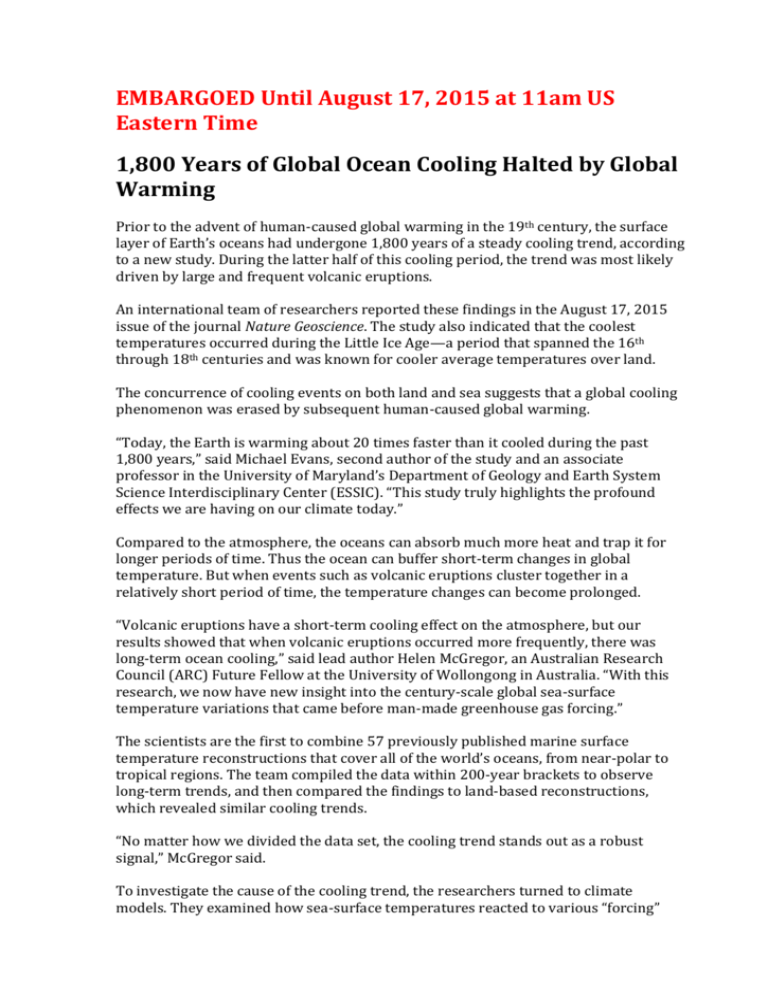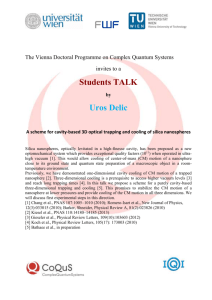University of Maryland (USA) press release (English, 13 August 2015)
advertisement

EMBARGOED Until August 17, 2015 at 11am US Eastern Time 1,800 Years of Global Ocean Cooling Halted by Global Warming Prior to the advent of human-caused global warming in the 19th century, the surface layer of Earth’s oceans had undergone 1,800 years of a steady cooling trend, according to a new study. During the latter half of this cooling period, the trend was most likely driven by large and frequent volcanic eruptions. An international team of researchers reported these findings in the August 17, 2015 issue of the journal Nature Geoscience. The study also indicated that the coolest temperatures occurred during the Little Ice Age—a period that spanned the 16th through 18th centuries and was known for cooler average temperatures over land. The concurrence of cooling events on both land and sea suggests that a global cooling phenomenon was erased by subsequent human-caused global warming. “Today, the Earth is warming about 20 times faster than it cooled during the past 1,800 years,” said Michael Evans, second author of the study and an associate professor in the University of Maryland’s Department of Geology and Earth System Science Interdisciplinary Center (ESSIC). “This study truly highlights the profound effects we are having on our climate today.” Compared to the atmosphere, the oceans can absorb much more heat and trap it for longer periods of time. Thus the ocean can buffer short-term changes in global temperature. But when events such as volcanic eruptions cluster together in a relatively short period of time, the temperature changes can become prolonged. “Volcanic eruptions have a short-term cooling effect on the atmosphere, but our results showed that when volcanic eruptions occurred more frequently, there was long-term ocean cooling,” said lead author Helen McGregor, an Australian Research Council (ARC) Future Fellow at the University of Wollongong in Australia. “With this research, we now have new insight into the century-scale global sea-surface temperature variations that came before man-made greenhouse gas forcing.” The scientists are the first to combine 57 previously published marine surface temperature reconstructions that cover all of the world’s oceans, from near-polar to tropical regions. The team compiled the data within 200-year brackets to observe long-term trends, and then compared the findings to land-based reconstructions, which revealed similar cooling trends. “No matter how we divided the data set, the cooling trend stands out as a robust signal,” McGregor said. To investigate the cause of the cooling trend, the researchers turned to climate models. They examined how sea-surface temperatures reacted to various “forcing” factors, such as changes in solar output, Earth’s orbit, land use, volcanic activity and greenhouse gases. Only volcanic events resulted in a cooling trend that matched the team’s real-world observations. Understanding how forcing factors changed ocean temperatures in the past can open a window into future climate change. “Model simulations by others have shown us that the oceans can impart a substantial delay in the warming of the surface climate,” said Evans, who is also the lead of the Ocean2k working group of the Past Global Changes (PAGES) program. “With much of the heat from global warming entering our oceans, recent ocean surface warming may foreshadow additional future warming, in the same way ocean cooling appeared as a long-term response to large and frequent volcanic events in recent centuries.” “We are still learning how the oceans mediate climate variations,” Evans added. “Further work combining both observations and simulations of ocean climate will refine our understanding of the ocean's role in climate change.” ### This research was funded by the National Science Foundation, the National Oceanic and Atmospheric Administration and the Swiss National Research Foundation via the PAGES (Past Global Changes) Program, as well as 22 additional grants and fellowships awarded to individual researchers and institutions. The content of this article does not necessarily reflect the views of these organizations. The research paper, “Robust global ocean cooling trend for the pre-industrial Common Era,” Helen McGregor, Michael Evans, et al., was published August 17, 2015 in the journal Nature Geoscience. Supplemental information about the study, including FAQs, data, figures, and photos are available on the PAGES website: http://www.pages-igbp.org/ini/wg/ocean2k/faq-pre Media Relations Contact: Matthew Wright, 301-405-9267, mewright@umd.edu University of Maryland College of Computer, Mathematical, and Natural Sciences 2300 Symons Hall College Park, MD 20742 www.cmns.umd.edu @UMDscience About the College of Computer, Mathematical, and Natural Sciences The College of Computer, Mathematical, and Natural Sciences at the University of Maryland educates more than 7,000 future scientific leaders in its undergraduate and graduate programs each year. The college's 10 departments and more than a dozen interdisciplinary research centers foster scientific discovery with annual sponsored research funding exceeding $150 million.




